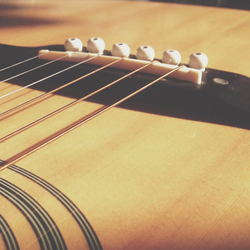Acoustic Guitar Saddle

The acoustic guitar saddle - while relatively unobtrusive - plays a very significant role in the guitar's tone and volume, since the saddle takes the vibrations from the strings and transfers them to the guitar's top. The saddle is such a subtle part of the guitar's construction that it is often overlooked. Many players don't even know their guitar has a saddle. Regardless, the saddle is an important part of the guitar's construction. A well-made saddle is a necessary part of a good-sounding guitar's tone, and most players don't pay much attention to them once they're in place and adjusted well. However, a poorly cut saddle or a saddle made of poor materials can have devastating effects on a guitar's tone.
As such, the saddle is a crucial component of the acoustic guitar's sound, so the shape, construction, and materials used in the saddle are incredibly important.
Materials
As you would expect, the material used in an acoustic guitar saddle affect the guitar's sound significantly. The material has to encourage a proper balance between tone and sustain. And not just any material will do. Common material in the past have included ivory (now virtually unused for obvious reasons related to the harvesting of ivory, though renowned for its warmth and richness) and bone (known for its balanced tone as well as sustain and charity). In addition to natural materials like bone and ivory, synthetic materials are increasingly more common, including Micarta (used by Taylor, Gibson, and Martin) as well as Graph Tech's Tusq saddles. Despite the rise in synthetic materials, bone is still a commonly used saddle material. Though metal saddles are common in electric guitars, metal saddles in the acoustic world are considered tone killers. Lower grade plastic is a common material as well, though used primarily on budget guitars.
Adjustments
As opposed to an electric guitar (which has individual saddles), an acoustic guitar has limited options when it comes to adjusting the saddle, simply because acoustic saddles are typically only one piece (though you will find some dual saddle acoustic guitars - I've seen these on Takamines - that offer compensated intonation) and are part of a set bridge that, unlike an acoustic guitar, does not lend itself to easy replacement. Still, other options include single saddles that are compensated and provide drop-in replacement for traditional saddles.
If you haven't noticed any issues with tone or intonation then the adage "if it ain't broke don't fix it" probably applies here. One reason why many players have never thought about their saddle intonation is that the vast majority of acoustic players don't venture much past the 7th fret (or even past the 3rd fret). If you're playing high on the fretboard, though, and notice some intonation issues, then a compensated saddle might be a worthwhile investment.
If you wish to adjust the action with an acoustic saddle, it's a relatively easy procedure. You simply sand the saddle down until you've found the optimal height for your playing style. Of course, if the saddle is outfitted with an electric pickup, you won't sand the bottom. Instead, shims are typically used to lower or raise the action.
Regarding intonation adjustment, the options are even more limited. You can replace the regular saddle with a compensated equivalent. Some luthiers perform even more radical "surgery" by relocating the saddle so that the intonation is improved. This procedure involves filling and painting the bridge slot itself, no small task, so if you need to have this done, make sure you pick a well-qualified luthier.
Replacement Options
Fortunately, there are numerous options for replacing stock acoustic saddles if so needed. There are hand-made options available in composite materials as well as natural materials like bone (I'm a big fan of Graph Tech products personally and find their Tusq saddles to be of very high quality - excellent intonation, sustain, and tone). You can also get saddles that have acoustic pickups built in if you wish to amplify your guitars. I have a couple of custom-made guitars that both use an LR Baggs LB-6 pickup that provides excellent tone in both acoustic and electric capacities. I combine them with an onboard mic (the LR Baggs Dual Source) for superb tonal versatility.
Common Problems with an Acoustic Guitar Saddle
Common issues that arise with acoustic guitar saddles are action (either too high or too low), intonation, and poor tone (often due to cheap materials such as plastic). Depending on the cost of the guitar, it may be worth taking your guitar to a luthier for a saddle adjustment or replacement. If your guitar is worth $200, it's likely not worth spending $100 to get a new saddle set up, though that depends upon how much the guitar means to you.
Add Your Comments Here!
I'd love for you to be a contributor to SoMuchGuitar.com!
Just fill out the information below to add to this page. I'll be in touch about your submission soon!